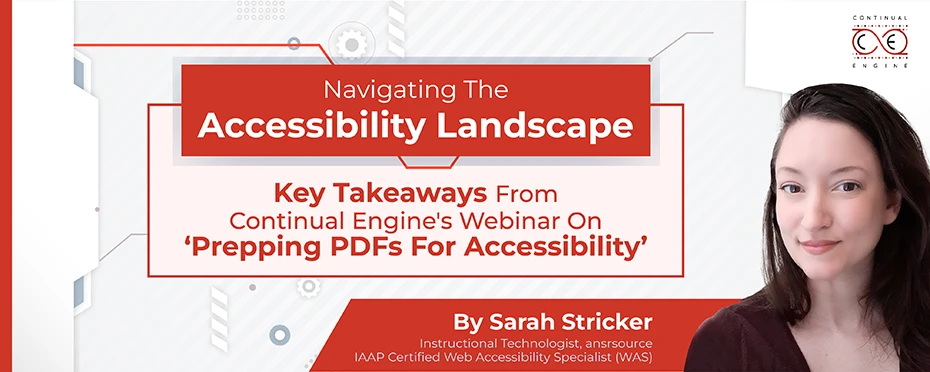In a digital-first world, PDFs have become a popular medium for sharing information. Owing to its rapid adoption, it is vital to ensure that PDFs are accessible to everyone, especially those using accessibility tools such as screen readers. To address this pertinent topic, Continual Engine recently hosted a webinar titled “Prepping PDFs For Accessibility”. With co-speaker Sarah Stricker, an Instructional Technologist and certified International Association of Accessibility Professionals (IAAP) Web Accessibility Specialist (WAS), the webinar’s primary objective was to offer valuable insights on creating visually appealing and user-friendly PDFs.
The webinar emphasized the importance of preparing documents for PDF accessibility by employing clear design principles, incorporating proper labels and text alternatives, and utilizing automated testing tools available in content authoring platforms. By following these practices, participants could gain practical knowledge to enhance the accessibility of their PDF documents, thereby ensuring an inclusive experience for all users.
This article aims to summarize the webinar’s key takeaways, invaluable insights, and best practices to help you create a more inclusive experience through the development of accessible PDFs. Let’s get started!
Six Key Takeaways On Accessible PDFs
Based on the informative webinar led by Sarah Stricker, we identified pivotal insights that provided valuable guidance on ensuring accessibility in educational materials.
Here are the six key takeaways we gathered from the discussion:
Accessibility Requires Continuous Efforts And Improvements
The journey to accessibility is continuous and demands constant upgrades. To ensure equal accessibility, it is imperative to adopt a holistic yet nuanced approach by prioritizing user needs throughout the content creation process.
PDFs Pose A Significant Accessibility Challenge For Users
For higher education institutions, publishers, or even financial institutions, practical strategies and tools are necessary to ensure that PDFs are accessible and compliant with accessibility standards. Taking proactive measures is essential to eliminate barriers and promote inclusivity.
Accessible PDFs Create A More Inclusive Learning Environment
Automation Enhances Efficiency And Remediation Turnaround Time
Manual remediation of PDFs can be time-consuming and resource-intensive. By leveraging automation tools such as PREP (PDF & Document Remediation Platform), institutions can streamline the process and efficiently remediate large volumes of PDFs with speed and accuracy.
Collaboration Helps Develop Better Accessibility Practices
Accessibility specialists, instructional designers, and content creators are crucial for driving advancements in accessibility. Working together enables the development of more inclusive practices, fostering innovation and accessibility improvements in educational materials.
Continuous Learning And Training Ensures Better Outcomes
With the implementation of these essential lessons, institutions and creators of content can aim for improved results and guarantee equitable access to educational resources for every learner.
What To Keep In Mind When Creating An Accessible PDF
As highlighted in our webinar, there are several key pointers to keep in mind when curating an accessible document. By following these pointers, you can create PDFs that are accessible and inclusive for all users.
Understanding The Challenges Of PDF Accessibility
The Significance Of Accessibility In PDFs
Accessible PDFs are designed to be perceivable, operable, understandable, and robust (POUR), following the official standard of PDF/UA (Universal Access) developed by the PDF Association. Abiding by Web Content Accessibility Guidelines (WCAG) ensures that individuals with disabilities can interpret, use, and understand PDF content effectively.
Emphasizing Clear And Simplified Design
While enhancing PDF accessibility, the importance of clarity and simplicity in document design cannot be understated. Using multiple columns, tables, or text box callouts is discouraged, as these elements can complicate the tagging process and lead to reading order errors. Instead, using appropriate headings and subheadings to structure content logically is encouraged while keeping images aligned with the text whenever possible.
Considerations For Formatting And Text
Careful formatting within OCR technology (Optical Character Recognition) is necessary to convert text from images. Content authoring tools that offer formatting options facilitate the indication of paragraphs, tabs, and text alignment. It is crucial to avoid manually inserting blank lines or excessive white space characters, as they can confuse screen readers and keyboard navigators.
Preparing Your Document
Using content authoring tools such as Microsoft Word, Microsoft PowerPoint, or Google Docs helps to streamline the document preparation process. These tools offer accessibility features that facilitate the creation of accessible PDFs. By following best practices during the content creation stage, many potential accessibility issues can be addressed proactively.
By incorporating these best practices, educational institutions and content creators can significantly promote equal access to information and foster inclusive learning environments for all users, regardless of their abilities or disabilities.
Final Thoughts
In conclusion, creating accessible PDFs is pivotal in ensuring accessible outcomes for all. By leveraging the key takeaways from Continual Engine’s webinar, “Prepping PDFs For Accessibility”, featuring Sarah Stricker, you can create and curate visually appealing and user-friendly PDFs. Through clear design, proper labeling, text alternatives, and automated testing tools, such as Continual Engine’s PREP (PDF & Document Remediation Platform), you can enhance the accessibility of their PDF documents.
When it comes to creating accessible PDFs, several considerations come into play. Understanding the challenges specific to PDF accessibility is essential, as is adhering to accessibility standards such as PDF/UA and WCAG. Emphasizing clear and simplified design principles, taking formatting and text into account, and utilizing content authoring tools, including PREP, to prepare documents are vital steps in ensuring accessibility.
The key takeaways from the webinar underscored the ongoing nature of accessibility efforts, the challenges posed by PDFs, the transformative impact of accessible PDFs on learning environments, the efficiency of automation tools like PREP, the collaborative efforts required for accessibility advancements, and the importance of continuous learning to stay abreast of evolving accessibility standards. By implementing the key strategies mentioned in this article and leveraging automation, inclusivity and an optimal user experience can be elevated to enable conducive learning environments for all individuals.
Interested in learning more about accessibility solutions?
Transform with Affordable Document Remediation
Experience top-tier PDF remediation powered by AI, delivering unmatched quality, precision, and scalability, all at a fraction of traditional time and cost.
